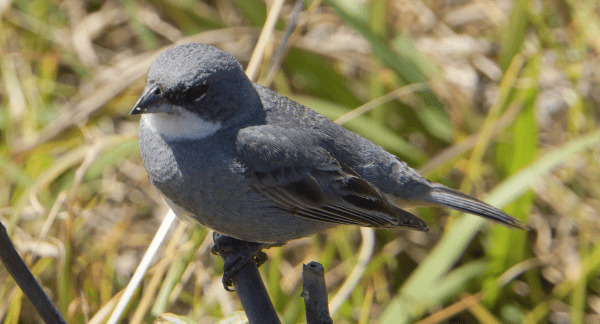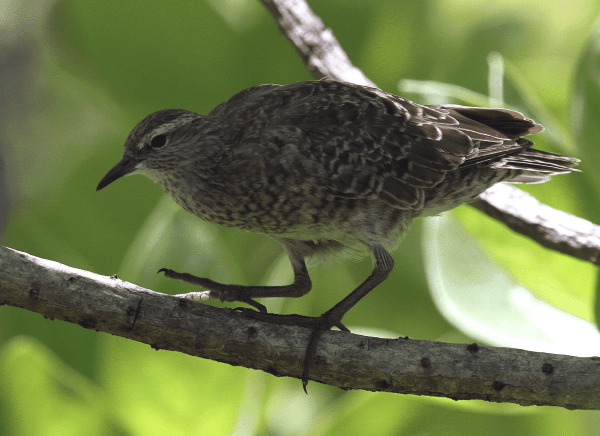We arrived off Ducie Island at dawn on October 12. The rough seas and the air above the low atoll in the Pitcairn group of the South Pacific were alive with birds. Most abundant were Murphy’s petrels – not surprisingly since some 95 percent of the world’s population of that species breeds on Ducie. But there were also Kermadec, Herald, and Cook’s petrels, a lonely Christmas shearwater, mobs of white terns, and many masked boobies. It was a splendid sight but also a depressing reminder of what might have been.
The Pacific was the last area of Earth invaded by Homo sapiens — in historic times, just a few thousand years ago. The fossil record and biogeography tell us that once there were hundreds of Ducie equivalents. Not only did those islands support hordes of breeding seabirds, but each hosted one or more endemic flightless rails as well as a variety of passerines. But thanks to the wonderful navigation abilities of the Polynesians, those biological riches are long gone. Over the past nearly half a century, we have sampled the residue of that biodiverse past, most recently in September-October of 2014, when we sailed with old friends of Zegrahm Expeditions in the southeast Pacific between Tahiti and Easter Island to take a quick look at the state of the area’s avifauna.
Over time we have watched Tahiti undergo “development” as a tourist destination. On this visit we were, for the first time, looking for the remaining handful of endemic birds. It was an unexpectedly stunning experience. We drove for several periods of a half hour or so through lush tropical forest without having a single bird, endemic or exotic, cross the road ahead of us. That was a unique experience among many hundreds of drives through tropical forests world-wide. We found a small population of the Tahiti reed warbler in a bamboo thicket in the Central (Papenoo) Valley. For unknown reasons the warbler, whose relatives are survivors on many South Pacific islands and show diverse behavioral patterns, had not become widespread on Tahiti despite the relative absence of other avian insectivores.[1] Another “target bird” was the Tahiti kingfisher which we found in small numbers. We did not get a chance to seek the critically endangered Tahiti monarch, a flycatcher down to fewer than 50 mature individuals. And, of course, we didn’t find the flightless Tahiti rail, last seen around the middle of the 19th century, when it presumably joined in extinction many other flightless rails from Pacific Islands. Nor did we spot any of the other ten or more bird species that once lived on the island. Neighboring Moorea was even more depauperate, lacking the Tahiti monarch.
According to John Curnutt and Stewart Pimm,[2] perhaps as many as 1500 bird species lived on the islands of the Pacific a few thousand years ago. Today there are roughly 230 persisting, a stunningly rapid decline. The reason, of course, was an invasive species, Homo sapiens. What did people do to transform relatively species-rich islands into ones with no native birds or a just a few, many barely hanging on by their wingtips? Excellent Polynesian navigators purposely carried domestic animals with them as they occupied the islands of the Pacific. Of those, the most destructive to avian diversity was the small Polynesian rat, Rattus exulans, a valued food source for the spreading human populations. The rats were transported in natural cells in the stems of giant bamboo, ironically not a plant native to the islands. The birds on the islands had evolved no defenses against mammalian predators and proved extremely vulnerable. By eating the eggs and young of island birds, the rats quickly reduced population sizes, often to extinction. When the Europeans invaded the islands a few hundred years ago they carried with them the black or ship rat (Rattus rattus) and Norway rat (Rattus norwegicus), even more dangerous predators than their Polynesian cousin. People also released habitat-destroying pigs, cattle, and rabbits. And in some places they also introduced that deadly enemy of birds and small mammals, the pussycat. As a result, the vulnerable birds on islands, because of their lack of evolutionary experience and the destruction of their habitats, mostly disappeared. While many bird species are in trouble today all over the world, those that lived on islands have suffered the highest rate of extinctions.
We saw the results of this onslaught throughout our trip. On the low atolls of the northern Tuamotu islands, the rare spectacled terns at Rangiroa could only successfully breed on a tiny rat-free islet. Toward the southern end of the archipelago, the unusual Tuamotu sandpiper is still present on a few rat-free atolls. This sandpiper has evolved a sedentary rather than migratory life style. It forages in dry sand, bushes, and trees, taking insects and even sometimes nectar, and still apparently nests on the ground. If rats make it to just a few more Tuamotu atolls, this fascinating creature will be gone forever, with only photos, like the accompanying beautiful image by Peter Harrison, the world’s leading sea bird biologist, to remember it by.
On Nuku Hiva, in the Marquesas, we were lucky enough to see the giant Nukuhiva pigeon, the largest member of its family that resembles the common pigeon (the huge crowned pigeons of New Guinea and adjacent islands don’t). The Nukuhiva pigeon the second heaviest in the world, at about two pounds exceeded in weight only by the crowned pigeons (seven pounds), as well as its famous, now extinct relative, the dodo (which may have weighed up to 40 pounds). A few years ago Nukuhiva pigeons were down to a relative handful of individuals, but suppression of hunting has permitted resurgence to some 300 birds. The pigeon once had a wider distribution in the Marquesas but is extinct elsewhere except for a small but growing reintroduced population on another island in the Marquesas. Some think its persistence on Nuka Hiva may be due to rugged terrain in an area that makes penetration by introduced rats, cats, pigs, and hunters difficult. Two other native birds have survived on Nuku Hiva: the beautiful white-capped fruit dove, and the northern Marquesas reed warblers.
A rough 45-minute Zodiac ride from Nuku Hiva took us to Tuahata, a rat-infested island with a tiny population of the endangered Marquesas kingfisher. After a scrambling hour and a half fruitless search, one (and seeing a couple of horses on an overgrazed hillside), time was approaching for the long, soaking/slamming Zodiac trip home against the wind. Then Peter Harrison shouted “kingfisher” and a half dozen dedicated birders dashed to him. He had been searching for a calling reed warbler, and as he scanned there was the prize kingfisher sitting calmly on a branch, filling the field in a spotting scope and displaying the diagnostic entirely white crown of its head. For twitchers, it was worth it.
After the Tuamotus and Marquesas, we visited the Pitcairn Islands, a group of four some thousand miles southeast of the Marquesas. The first visit was to Pitcairn itself, of Mutiny on the Bounty fame. Its occupation by descendants of the mutineers for more than two centuries had killed off all of its endemic birds except for the Pitcairn reed warbler through habitat destruction and the introduction of Polynesian and black rats, cats, and other exotic animals. A few years earlier an attempt to exterminate the rats and cats on this complex high island had failed, and the rats had come booming back. Cats were then reintroduced in the hope they would serve as a sort of biological control. But the original hope that the island could again serve as a major seabird breeding base, one not threatened by sea level rise, was not fulfilled. The warblers were amazingly abundant, displaying a high degree of albinism (inbreeding) and un-warbler-like behavior, even hunting bugs on lawns, but other birds were absent.
Our next stop was Henderson island in the Pitcairn group, a “makatea” (chunk of raised coral reef) with cliffs about 40 feet high and covered with an almost undisturbed forest growing on razor-sharp coral. It has been declared a World Heritage site. The island boasts four endemic land birds, the Henderson rail, fruit dove, lorikeet, and reed-warbler, and more than 50 other organisms found nowhere else. We were forced by sea conditions to land on a small beach with almost no access to the interior, but nonetheless were able to see the warbler and the lorikeet, and a few lucky people spotted the dove and the rail. We all saw lots of rats, however, and thereby hangs a tale. In 2011 a multimillion dollar operation was mounted by the Royal Society for the Protection of Birds and the Pitcairn government to annihilate the rats. A ship brought two helicopters to Henderson to distribute poisoned bait, and it was thought the operation was a success. But a rat was briefly filmed by a member of a National Geographic Society expedition in March 2012, and a rapid response team of the RSPB confirmed their presence in May. The Society and the Pitcairn government are determined to repeat the de-ratting campaign, but it is expensive and success cannot be assured. If you wish to help in this important effort, go to the RSBP web site.[3]
This brings us back to Ducie Island, more than 100 miles east of Henderson. This very low-lying atoll is extremely vulnerable to rising sea level and storm surges. One hope in de-ratting Henderson is that many of the sea birds nesting in huge numbers on Ducie might be able to switch to Henderson as the Pacific sea level inexorably rises. So the future of a great number of bird populations rests on a contest between climate disruption and Polynesian rat resilience.
Our last stop was Easter Island, one of the most isolated islands in the world, some 1200 miles east of the Pitcairn group and 2000 miles from South America. Easter Island is the site of an ecocatastrophe, made famous by Jared Diamond.[4] All of its native birds are extinct, replaced by a collection of “garbage birds” (ones not sought by bird-watchers), especially the wide-ranging South American Diuca finch pictured here, which flits among the looming stone heads.

The state of the birds on these islands is a harbinger of a catastrophe that looms globally, But that will have to wait for a future blog.
[1] Cibois A, Beadell JS, Graves GR, Pasquet E, Slikas B, Sonsthagen SA, Thibault J-C, Fleischer RC. 2011. Charting the course of reed-warblers across the Pacific islands. Journal of Biogeography 38: 1963–1975.
[2] Curnutt J, Pimm, S. 2001. How many bird species in hawai’i and the central pacific before First contact? Studies in Avian Biology No. 22:15-30.
[4] Diamond J. 2005. Collapse: How Societies Choose to Fail or Succeed. New York, NY: Viking.
MAHB-UTS Blogs are a joint venture between the University of Technology Sydney and the Millennium Alliance for Humanity and the Biosphere. Questions should be directed to joan@mahbonline.org
MAHB Blog: https://mahb.stanford.edu/blog/collapse-of-avian-biodiversity/
The views and opinions expressed through the MAHB Website are those of the contributing authors and do not necessarily reflect an official position of the MAHB. The MAHB aims to share a range of perspectives and welcomes the discussions that they prompt.

